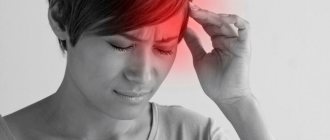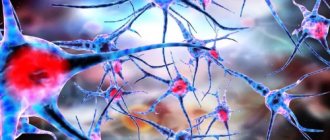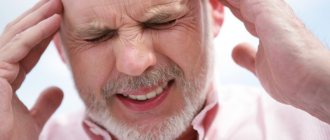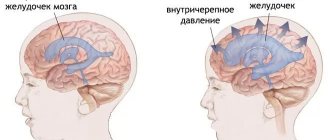Tension headaches (TTH) are the most common type of headache. According to various sources, 30-78% of people worldwide suffer from them, while the more well-known migraines are observed only in 8-20%. They are most often observed in women over 20 years of age, although they are often found even in schoolchildren. But it is extremely rare for the first time that HDN occurs after 50 years of age.
Tension headaches are the primary forms of headaches or cephalgia and are not caused by organic changes in the brain and blood vessels. But, despite the benign origin, pain in the head significantly limits a person, reduces his performance and quality of life in general. Therefore, no less than other types of cephalgia, it requires consultation with a neurologist and competent treatment.
Previously, tension-type headaches were considered a psychogenic disorder and were called muscle tension pain or stress cephalalgia. But studies have shown that they still have a neurobiological origin.
Some statistics
Headache is the most common nonspecific symptom worldwide. Almost every person on earth has at least once experienced a feeling associated with a headache, and on an ongoing basis this symptom occurs in more than 60% of the world's population, which makes the introduction of the latest laboratory diagnostic and therapeutic measures an urgent problem in modern healthcare in the largest countries of the world.
Most people simply complain of headaches and do not realize that in 75-80% of cases they suffer from tension-type headaches - the main type of cephalgia in neurological practice.
What is a tension headache?
Headache or cephalgia is a complex symptom of a nonspecific nature that occurs under the influence of a developing pathological condition in the patient’s body. When you feel a headache, you might think that the nerve tissue of the brain itself is hurting, but this is not the case. There are no pain receptors in the nervous tissue of the brain, and the patient experiences the entire range of pain sensations arising from cephalgia due to receptors located in the periosteum of the skull, cerebral arteries, muscles of the head and neck, peripheral sensory nerves, subcutaneous tissue, eyes and mucous membranes. The entire spectrum of sensations is formed precisely as a result of overstimulation of the nerve receptors of the above-described areas, which directly forms cephalalgia itself.
From this we can conclude that depending on the tissue involved in the occurrence of pain, the nature of cephalgia will change, which is why in neurological practice it is convenient to distinguish several types of cephalgia, including tension headache.
Diagnosis of tension-type headache
If you often have a headache, you should definitely consult a neurologist. It would be good to prepare for a visit to a specialist and start keeping a diary in advance, in which you should note all episodes of headaches, describe their nature, strength, location and factors preceding their appearance. It is also worth writing down what helped stop the attack.
TTH have quite characteristic symptoms, which in most cases make it possible to differentiate them from other disorders, including organic brain lesions, already at the first consultation. To do this, the doctor initially interviews the patient and asks him to mark the intensity of painful sensations on a special scale or verbally assess their severity from 1 to 10, i.e. the VAS technique is used.
When determining the type of headache, a VAS scale (visual analogue scale) must be assessed. For HDN it is typical to obtain an indicator of up to 6 points, usually in the range of 3-5.
The main distinguishing features of tension headaches are:
- duration of attack from 30 minutes to 7 days;
- absence of nausea and vomiting;
- the presence of either photophobia (fear of light) or phonophobia (intolerance to loud sounds), but not their simultaneous combination;
- lack of connection with other disorders.
TTH is indicated by the presence of pain that meets at least 2 of the following parameters:
- two-way localization;
- pressing or squeezing character, but never pulsating;
- low to moderate intensity;
- lack of gain during ordinary physical activity, in particular when walking, going up or down stairs.
Additional diagnostic signs of tension headaches are:
- girdling pain like a hoop or helmet;
- increased pain due to anxiety, negative emotional experiences;
- reduction of pain with positive emotions and psycho-emotional relaxation.
This alone allows us to confirm with a high degree of probability the presence of tension headaches. But as part of the initial examination, an examination of the pericranial muscles is required, as well as an assessment of the neurological status. To do this, the doctor lightly presses and makes small rotational movements with the second and third fingers on the forehead, temples, area of mastication, trapezius and other muscles of the head and neck. During this, he can detect muscle tightness, and the patient must be informed about the severity of pain on a ten-point scale. Also during the examination, special neurological tests are performed. This is usually sufficient to diagnose tension-type headache and select appropriate treatment for the situation.
TTH is rarely accompanied by other neurological disorders.
If during the examination and questioning of the patient other symptoms are found that are not characteristic of tension headaches, additional research methods are prescribed:
- CT scan or x-ray of the cervical spine;
- MRI of the cervical spine and head;
- Doppler ultrasound of the vessels of the neck and head, etc.
With their help, it is possible to detect other disorders that may accompany HDN and worsen the patient’s condition, in particular osteochondrosis, atherosclerosis, vertebral artery syndrome, VSD.
Classification
In the International Classification of Diseases, 10th revision, headache is coded under R51 and refers to typical disorders of the nervous system.
It is customary to distinguish two main variants of cephalgia, according to the etiological principle:
- Primary headache. This type of headache includes tension headache or tension headache, as well as migraine.
- Secondary headache. It does not arise independently, i.e. is formed under the influence of any pathological process occurring in the nervous tissue. For example, a secondary headache may occur as a result of oncological damage to the central nervous system or due to atherosclerotic damage to the cerebral vessels.
In addition to the etiological classification, there is also a pathogenetic classification of cephalgia, which includes types such as:
- Vascular headache. Vascular pain occurs as a result of spasm of the smooth muscles of the vascular walls, which leads to an increase in blood pressure in the cerebral basin and ischemia of brain tissue. In the opposite case, headache can also occur due to dilatation of the vascular bed or as a result of a violation of the rheological properties of the blood, which also leads to tissue hypoxia and ischemic damage.
- Muscle tension pain. In this case, overstimulation of the neuromuscular synapses occurs, which leads to excessive muscle tension and spasticity.
- Liquorodynamic pain. This type occurs as a result of changes in intracranial pressure, regardless of whether an increase or decrease in intracranial pressure occurred. Changes in pressure in the ventricles of the brain can lead to dislocation of brain structures, which ultimately creates pain.
- Neuralgic cephalgia. It is formed as a result of irritation of peripheral nerve fibers as a result of an extraneural or endoneurial pathological process. In this case, the mechanism of cephalgia is associated with the formation of a focus of pathological activity in the nociceptive system of the brain.
- Psychogenic. With this type, there are no pathological changes in tissues anatomically close to the nervous tissue. In this case, a malfunction occurs in the antinociceptive system of the brain, which leads to various disorders in the neurotransmitter dopaminergic system of the brain and the occurrence of pain. The main mechanism is disruption of the production of endogenous opiates.
- Mixed genesis. It occurs under the influence of the combined influence of the pathological process on the tissues surrounding the brain. The pathological effect can be either simultaneous or sequential.
Types of HDN
First of all, it is worth identifying the subspecies.
- Episodic pain occurs no more often than about 18 times a month, and a single attack lasts no more than half an hour. The severity of pain is usually low.
- Another type, chronic tension headache, is noticeably high in intensity. Patients have attacks more than 20 times a month, or more than 180 cases per year. Often this type of pain is accompanied by the appearance of depression.
Types and reasons
Tension headaches are divided into:
- infrequent episodic - occur several times a month, go away on their own or are easily eliminated with conventional painkillers (in such cases, people rarely seek medical help);
- frequent episodic - present for no more than 15 days during 1 month or up to 180 days a year, they can also go away on their own or soon after taking a painkiller;
- chronic - present more than 15 days a month or more than 180 days a year, i.e. they can occur very often or daily (in severe cases, patients may not have pain-free intervals at all).
In all cases, the attack can last several minutes or drag on for several days.
An attack of tension-type headache can occur with or without tension in the muscles of the head, neck and face. In the first case, there will be additional pain in them.
Thus, TTH is mainly divided according to the frequency of occurrence. Most often, neurologists are faced with cases of frequent episodic and chronic tension headaches. Moreover, frequent episodic pain tends to transform into chronic pain. This is facilitated by:
- Depressive disorders and chronic stress caused by the accumulation of traumatic life events, finding oneself in situations that cannot be resolved, special personal characteristics, and incorrect behavioral strategies for dealing with pain.
- Drug abuse is the excessive use of painkillers of various kinds, including single-component analgesics and combination drugs containing additional sedatives, caffeine, etc. In such situations, the chronicity of pain occurs 2 times faster than with proper use of painkillers. At the same time, the development of drug abuse significantly complicates treatment and, first of all, requires complete withdrawal of the drug that provoked it.
- The muscle factor is overstrain of the pericranial muscles (neck, face and head), which accompanies long-term maintenance of a forced body position during work. This can create a vicious circle where muscle tension, which is essentially a spasm, leads to nerve irritation, which causes more pain in the head, which in turn causes even more muscle tension. The situation is aggravated by the experience of emotional stress, increased anxiety and depression.
The main cause of tension headaches is emotional stress. Somewhat less frequently, they are caused by prolonged stay in a static position, which provokes tension in the pericranial muscles. But the latter may also be a consequence of pathologies of the cervical spine, which often provoke reflex spasms of muscle fibers. In this case, neck pain may additionally be present.
Osteochondrosis of the cervical spine is an extremely common disease characteristic of representatives of sedentary professions. The changes that occur in the intervertebral discs lead to the development of an inflammatory process and the appearance of painful sensations, which causes the development of muscular-tonic syndrome. This starts a vicious circle of development of tension-type headache. If left untreated, pathological changes in the discs progress, which can lead to compression of the spinal roots and the development of neurological complications, one of which is severe pain in the back of the head.
Sometimes there is a combination of migraines and episodic tension headaches. But generally, patients can independently distinguish one attack from another.
Features of tension headaches
Tension headache or tension cephalgia, as mentioned above, is the most common option among all types of cephalgia. This type of headache is usually functional in nature and does not have a high degree of intensity or duration. Tension headache should not be confused with migraine, despite similar pathogenetic mechanisms of formation; with migraine, the pain syndrome is much more pronounced and manifests itself as localized pain mainly in one of the hemispheres of the brain. Unlike migraines, tension headaches cause diffuse pain.
Clinical picture
Tension headaches have the following characteristic symptoms:
- Painful sensations of a diffuse nature.
- Pain can come from the parietal part of the head, forehead, temples, but the entire head is necessarily included in the pain process.
- Patients describe the nature of the sensation as squeezing, pressing or twisting.
- The intensity of pain can vary from mild to moderate intensity. With tension headaches, the pain is never too intense or severe.
- The duration of pain can vary significantly, from a few minutes to several days.
It is important to note that a small proportion of people with tension headaches may experience additional symptoms, such as photophobia.
The symptom of head compression in neurological practice is sometimes called the “neurotic helmet”, since many patients complain of a feeling of head compression in all areas. In most patients, tension-type headaches are symmetrical, but asymmetrical headaches may also occur.
Two thirds of patients experience episodic headaches, i.e. they occur only with any functional impairment, but approximately 30% of patients are diagnosed with chronic tension-type headache. The main criterion is the frequency of occurrence of attacks; to establish a chronic form, headaches must occur at least 15 episodes of headaches within a month and over a period of three months.
The Clinical Institute of the Brain is actively studying the processes of formation and manifestation of tension headaches, which makes it possible to introduce new original, and most importantly, effective treatment regimens into medical practice.
Treatment of tension headaches
Treatment tactics for tension-type headache are determined individually by a neurologist. The doctor takes into account the frequency of attacks, their strength, the presence of concomitant disorders, and the psychological state of the patient. With frequent episodic and chronic tension-type headaches, an integrated approach is always required, designed to break the links in the vicious circle of pain development and normalize both the psycho-emotional state of the patient and eliminate excessive muscle tension and the pain itself.
When developing treatment tactics, the neurologist is guided by the following fundamental principles:
- treatment and prevention of emotional and personal disorders, which include not only depressive disorders, but also increased anxiety, various phobias, somatoform diseases, etc.;
- treatment and prevention of muscle tension;
- eliminating or preventing the occurrence of drug abuse.
Therefore, patients with tension headaches are recommended not only drug therapy, but also non-drug methods, in particular psychotherapy, therapeutic massage and manual therapy, physical activity, especially visiting the pool, yoga, etc.
When prescribing treatment, the patient must be explained the nature of headache attacks and focus on the role of emotional factors, as well as excessive tension in the muscles of the head and neck. Therefore, it is very important to learn to avoid such undesirable influences, that is, try not to enter into conflicts, react more calmly to various life circumstances, and also take regular breaks from work, and if it involves a long stay in a static tense position.
If a patient notices a decrease in visual acuity, eye strain while working at a computer, reading, etc., he needs to consult an ophthalmologist. If indicated, glasses are prescribed, which must be worn to avoid visual strain.
Drug therapy
Pharmacotherapy for tension-type headache includes not only painkillers, which should be taken to relieve an attack, but also a number of other drugs aimed at eliminating muscle spasms and normalizing the psycho-emotional state. All of them are selected strictly individually, taking into account concomitant pathologies and other features. Most often, patients are prescribed:
- sedatives - help calm, eliminate anxiety, some increase drowsiness, which allows you to normalize sleep with their help, but limits use in the morning and during the day;
- antidepressants – used to treat depression, help improve mood, eliminate anxiety, irritability, emotional stress, improve sleep quality;
- neuroleptics - indicated for severe forms of mental disorders, mania, phobias, as they suppress psychomotor agitation and emotions;
- muscle relaxants - indicated when signs of overstrain of the pericranial muscles and their soreness are detected, including those that arise or increase with palpation;
- anticonvulsants – help to deeply eliminate muscle spasms and stabilize the emotional state;
- botulinum toxin injections - used in some cases with severe overstrain of the pericranial muscles.
The duration of treatment for tension headaches is at least 3 months. In most cases, the course takes 4 months, less often it is extended to 6 months. If you stop therapy earlier, the likelihood of attacks returning with the same intensity increases sharply.
If tension headaches are combined with migraines, β-blockers, calcium channel blockers, etc. are additionally prescribed.
To relieve an attack, it is recommended to take painkillers, in particular NSAIDs and combination drugs. This:
- paracetamol (Panadol, Efferalgan);
- ibuprofen (Nurofen, Imet, Mig);
- nimesulide (Nimesil, Nise);
- diclofenac (Voltaren, Diclak, Ortofen);
- ketoprofen (Artrum, Ketonal, Flamax, Flexen);
- ketorolac (Dolak, Ketanov, Ketocam, Ketolac);
- combined (Spazmalgon, Sedalgin-neo, Solpadeine).
But the main rule for using analgesics is to use them no more than 10 times a month! This is necessary to avoid the development of drug abuse and resulting headaches. But such drugs should be used with great caution in the presence of diseases of the gastrointestinal tract, in particular gastritis, gastric and duodenal ulcers. Oral drugs from the NSAID group have an irritating effect on the mucous membranes of the gastrointestinal tract, i.e. they have an ulcerogenic effect. This can provoke an exacerbation of chronic gastroenterological pathologies and cause abdominal pain of varying degrees of intensity.
Even with rare attacks of tension headaches, patients with gastrointestinal diseases should consult a doctor for an individual selection of an anesthetic drug.
The following also help reduce pain:
- resting with a damp towel over your eyes in silence in a dark room;
- warm shower or bath;
- massage of the neck and temples.
Psychotherapy
Since tension-type headaches are very often associated with disorders and instability of psychological state, it is recommended to consult a psychotherapist and follow his recommendations. Individually selected psychotherapeutic techniques help eliminate the main trigger for the development of attacks or reduce its impact on a person’s well-being.
In particular, cognitive behavioral therapy has proven itself to be effective for tension headaches. It is based on the principles of cognitive and behavioral therapy and allows you to learn to detect, objectively evaluate and respond more correctly not only to external stimuli, but also to your own thoughts. As a result of regular practices, a person develops new, more advanced ways of behavior, which are subsequently transformed into full-fledged behavioral models and no longer require such careful self-control and self-analysis.
Massotherapy
Massage therapy is an effective and safe way to relax and treat tension headaches. It has virtually no contraindications and can be performed even during pregnancy and children.
During therapeutic massage, a specialist acts on the muscles of the back and neck, which leads to increased blood circulation, accelerated metabolism, and also helps to improve the functioning of the nervous system and eliminate stagnant processes. A qualified doctor can achieve complete relaxation of overstrained muscles of the collar zone, and the positive emotions experienced by the patient during the session lead to the release of endorphins and the elimination of psychological stress.
At the same time, competent impact on the pericranial muscles allows you to speed up the process of their recovery and increase the elasticity of the fibers, which allows you to eliminate chronic spasm and quickly achieve improved well-being. This also makes it possible to eliminate irritation of the nerves by compressed muscles and avoid chronic headaches. Additional positive properties of therapeutic massage are increased performance and improved sleep quality.
In his work, the specialist uses various methods of influence, including stroking, rubbing, kneading and vibration. Their use in an individually determined order and force allows you to obtain a pronounced effect, noticeable after the first session.
Manual therapy
Therapeutic massage and manual therapy are not the same thing, and the main difference between these methods is the depth of impact and the techniques used. For HDN, both methods can be used both together and separately.
Manual therapy involves deep work on muscles, joints and ligaments, in particular the spinal column. It is indicated even in the absence of spinal pathologies, and if they are present, it is irreplaceable. Such a high importance of manual therapy is explained by the fact that the work of all organs depends on the condition of the spinal cord and the spinal roots extending from it, which are protected by the spine. Therefore, influencing it and restoring the correct position of the vertebrae, intervertebral discs, eliminating the slightest deformations with additional training of the muscles of the back and neck helps to improve the functioning of all organs, well-being, mood and reduce anxiety.
Manual therapy of the back and neck is especially important when diagnosing osteochondrosis that accompanies tension-type headaches or is the cause of their occurrence. It also allows you to overcome muscle-tonic syndrome and completely break the vicious circle of pain.
In other cases, post-isometric relaxation (PIR) and so-called craniosacral manual therapy are recommended. PIR is a method of soft, gentle influence. Thanks to its use, it is possible to achieve maximum relaxation and stretching of the muscles in the affected area, increasing their elasticity and, accordingly, eliminating pain.
Craniosacral therapy involves influencing the bones of the skull and working on the vertebrae of the cervical spine. As a result of competent and extremely careful actions of a specialist, it is possible to improve or even completely normalize the blood supply to the brain, which is especially important in case of vertebral artery syndrome. But, more importantly for patients suffering from headaches, craniosacral therapy makes it possible to eliminate attacks, including migraines, and also improve a person’s cognitive abilities. All this has an extremely positive effect on the patient’s performance and psychological state, which is the key to a progressive reduction in the frequency of attacks and their intensity.
Moreover, manual therapy can be performed even on pregnant women and children.
Causes
The etiological factor leading to the development of tension headaches can be a large number of pathological conditions occurring in the body. The main causes of tension headaches include:
- Frequent stressful situations. After studies conducted to study the clinical course of tension headaches, it was concluded that pain most often develops in the second half of the working day after significant stressful situations or as a result of prolonged hard work.
- Violation of rest and wakefulness. One of the most common causes of cephalgia. Constant lack of sleep or poor quality of night sleep leads to insufficient restoration of the central nervous system, which causes overstrain and headaches.
- Starvation. Malnutrition, rare or monotonous nutrition leads to insufficient supply of nutrients to brain tissue and dystrophic manifestations in neurons, primarily manifested in the form of cephalgia. A special case of fasting is the development of a hypoglycemic state, in which the brain lacks glucose.
- Hypertension or isolated arterial hypertension. An increase in systolic pressure leads, or less commonly, a decrease, which can cause the development of tension cephalgia of a vascular nature.
- Premenstrual syndrome is a common cause for women. It has been observed that tension headaches occur more often in females, especially during premenstrual syndrome.
At a neurological appointment, headache ranks second after complaints of pain in the lower back. 85% of the population experiences it periodically. About 40% have reduced social and work activity and require qualified treatment.
Relevance
In only 5–6% of patients, the cause of headaches (HT) is severe organic diseases: tumor, traumatic brain injury, infection, vascular pathology, etc. In other cases, we are talking about benign primary headaches, among which headache is the most common voltage (GBN). Its lifetime prevalence ranges from 30% to 78%.
According to a population study (2009–2011), in one year this figure was 30.8%. Women are affected more often than men (ratio 5:4). The average age of onset of tension-type headache is higher than that for migraine—25–30 years. Recent analysis of various forms of headache has shown that the degree of maladjustment and socioeconomic harm associated with tension headache is greater than that of migraine. But there is no data confirming the involvement of genetic mechanisms in the origin of HDN.
Classification
TTH refers to primary (benign) cephalgia, which is not associated with organic damage to the brain and other structures located in the head and neck area.
There are infrequent episodic tension-type headache (EGTH) - 1 day or less per month, frequent EGTH - from 1 to 14 days per month, chronic tension-type headache (CHTH) - more than 15 days per month (or more than 180 days during the year). In addition, depending on the presence or absence of muscle dysfunction, a distinction is made between EGTH and CGTH with and without tension in the pericranial muscles. The latter is determined by palpation of the muscles of the craniocervical zone. If one or more diagnostic criteria for TTH are not met, a diagnosis of “possible TTH” may be made.
The most common occurrence is EGTH, which does not require treatment. In 24-37% of the population, episodes of tension-type headache occur several times a month, in 10% - weekly, and in 2-3% they are chronic. Mostly, patients with CGTH or frequent EGTH (more than 8–10 days per month) consult a doctor.
Risk factors and triggers
The main risk factors for tension-type headache are the inability to psychologically and muscularly relax, and insufficient night sleep. The most common causes are emotional stress (acute or chronic) and postural tension (prolonged stay of the head and neck in a forced, uncomfortable position). With distraction or positive emotions, the pain may weaken or disappear completely, and with the resumption of emotional stress and/or muscle/postural tension, it may intensify again. The main risk factors for increased frequency (chronicity) of painful episodes of tension-type headache include drug abuse (excessive use of painkillers) and mental disorders, primarily depression, anxiety and somatoform disorders.
Diagnostics
It is carried out in accordance with the criteria of the International Classification of Headaches (3rd edition, beta version) and is clinical, that is, based on an analysis of complaints, medical history and neurological examination. Additional studies are not required, since they do not reveal changes specific to TTH. They are carried out only according to indications, the main of which are the presence of danger signals and suspicion of the symptomatic nature of cephalalgia (doubt about the probable clinical diagnosis of tension-type headache).
Diagnostic criteria for tension-type headache
A. The duration of the headache is from 30 minutes to 7 days.
B. The headache has at least 2 of the following characteristics:
- two-way localization,
- pressing/squeezing/non-pulsating character like a “hoop” or “helmet”,
- mild or moderate intensity (no more than 6–7 points on the visual analog pain scale),
- the pain is not worsened by normal physical activity (walking, climbing stairs).
C. Both of the following symptoms:
- no nausea or vomiting,
- only one of two symptoms: photophobia or phonophobia.
D. The headache is not associated with other causes.
As a rule, the neurological status of patients does not reveal organic disorders. During the examination, signs of increased anxiety, vegetative dystonia, and the patient’s inability to psychological and muscular relaxation may be revealed. Due to frequent complaints of tension and pain in the neck and back of the head, it is important to assess the condition of the pericranial muscles. Palpation should be carried out with small rotational movements with the 2nd and 3rd fingers while applying pressure in the area of the temporal, masticatory, sternocleidomastoid, trapezius, as well as the posterior group of neck muscles (belt muscles, inferior obliques). The diagnosis of “cervical muscular-tonic syndrome” or “pericranial muscle tension” is made in the presence of severe pain up to the “jumping symptom” (due to muscle pain, the patient actively resists palpation) in two or more muscle groups.
To determine the form of HDN, you need to set the number of days with HDH per month. The diary helps the patient and the doctor determine the frequency of headaches, the number of dosages of painkillers taken to relieve it, and confirm or, conversely, exclude drug abuse.
The patient should also be asked about comorbid disorders that may further impair quality of life and require therapeutic correction. Among the most common of them, patients with TTH are found to have depression, anxiety disorders, including panic attacks, somatoform and senesto-hypochondriacal disorders, night sleep disorders, and other pain syndromes, including fibromyalgia. Emotional and personality disorders maintain muscle tension and pain, lead to serious maladjustment and are one of the main factors in the chronicity of tension-type headache.
Treatment
Involves relief of painful episodes and preventive treatment. Before choosing a tactic, you should conduct behavioral therapy, which includes:
- explaining to the patient the benign nature of HDN and the mechanisms of its occurrence,
- dissuading the presence of an organic cause of headache,
- justification for the inappropriateness of additional studies (except for cases of suspected symptomatic HDN),
- substantiation of the role of muscle tension during prolonged stay in a monotonous position, emotional disorders (anxiety and depression),
- substantiation of the role of chronic emotional stress in maintaining pain and muscle tension,
- explaining the need for relaxation training.
Based on the basic mechanisms of the formation of tension-type headache, treatment should be comprehensive and aimed primarily at normalizing the patient’s emotional state and eliminating muscle tension, and, if necessary, at correcting other comorbid disorders and drug abuse.
Relief of painful episodes
Is the key point in the treatment of headache. When stopping attacks of tension-type headache, the most effective are: simple analgesics and NSAIDs (ibuprofen, ketoprofen, acetylsalicylic acid, naproxen, diclofenac, paracetamol). Treatment with them can be used in patients with episodic tension-type headache with a frequency of attacks no more than 2 times a week (no more than 8 days per month). With a higher frequency of pain episodes, there is a risk of drug abuse and the development of drug-induced headache.
Preventive tactics
The main goals are:
1. Reducing the frequency, duration, intensity of headaches.
2. Improving the effectiveness of symptomatic analgesic therapy.
3. Restoring the patient’s daily activity and quality of life.
Before starting preventive pharmacotherapy, it is necessary to make sure that non-drug treatment methods are insufficiently effective. These include:
1. Sleep hygiene.
2. Regular health-improving sports activity (preference to aerobic activity, about 20–30 minutes a day).
3. Regular diet (avoid skipping meals, have a full breakfast).
4. Limit intake of caffeine and stimulants.
5. Identifying and eliminating triggers.
6. Behavioral therapy, psychotherapeutic correction:
- relaxation methods (progressive muscle relaxation, self-hypnosis, breathing-relaxation training, autogenic training),
- cognitive behavioral therapy.
7. Alternative approaches (acupuncture, herbal medicine, aromatherapy, Chinese traditional therapy).
Preventive therapy is indicated for patients with chronic TTH and frequent episodic TTH. Before starting it, it is necessary to explain to the patient the mechanism of action and possible side effects of the prescribed drugs (primarily antidepressants, which also have an analgesic effect). For better tolerability, the minimum dosage is initially prescribed, followed by a slow increase in dose to an adequately tolerated dose. Prevention that seems ineffective should not be interrupted quickly: 2–3 months is the minimum period to achieve a therapeutic effect. The duration of therapy is from 6 months to 1 year. To assess effectiveness and improve compliance, keeping a diary is recommended.
Muscle relaxants are used as additional therapy, especially in patients with severe tension in the pericranial muscles (tizanidine, tolperisone). The average duration of treatment is 2 months. Since the clinical effect of muscle relaxants occurs more quickly than that of antidepressants, the administration of combination therapy (antidepressant + muscle relaxant) may improve the effectiveness of treatment.
Treatment and prevention of tension-type headache is a complex multidisciplinary task, fraught with certain difficulties and requiring the formation of strategies for changing daily activities, interpersonal relationships, and psychological correction.
Non-drug therapy methods are of high importance.
An integrated approach is the key to reducing the frequency and intensity of headaches and normalizing daily activity.
It is important to take into account the individual characteristics of patients when drawing up a treatment program: age, gender, concomitant somatic and endocrine pathology, abuse factor, characteristics of interpersonal relationships.
Diagnostics
As a rule, establishing a diagnosis of tension headache is not difficult, but confirming the diagnosis is a labor-intensive process. To confirm the diagnosis, the patient must undergo a series of diagnostic studies, which allow not only to confirm the disease, but also to find out the degree of its severity, as well as the main cause, which qualitatively improves the further treatment of the patient.
On the basis of the Clinical Institute of the Brain there is a powerful diagnostic center that has the most advanced diagnostic tools. At the clinic, the following is used to verify tension headaches:
- Ultrasound Dopplerography of the vessels of the head and neck to exclude or confirm atherosclerotic changes in the vascular wall.
For a more detailed and in-depth study of cerebral lesions, an X-ray examination - angiography - can be performed.
- Angiography of cerebral arteries followed by contrast allows one to accurately determine the location of vascular pathology.
- Tomographic research methods: computed tomography and magnetic resonance imaging allow detailed visualization of the tissues and structures of the brain, which has significant information weight in the diagnosis of headaches.
- Electroencephalography is a classic method and the gold standard for diagnostic studies of the brain. EEG allows us to determine the functional activity of the brain and headache-related disorders.
Development mechanism
The above causal factors trigger overexcitation in the median subcortical structures of the brain. The tone of the muscles of the neck and head increases. The pain sensitivity threshold decreases.
How to help
Tension headaches occur sporadically and do not require special treatment for a short time. In this case, it is enough to take a break from work, switch your attention, and give minimal physical activity (10 squats or push-ups).
Such pain should be treated as a signal of increased stress on the nervous system and psyche.
If the pain lasts more than 10-15 minutes, causes discomfort, distracts and interferes with current activities, you should do what is listed in the previous paragraph, take a shower or go out into the fresh air and walk (or jog) until you feel tired.
Drugs from the group of non-steroidal anti-inflammatory drugs can help: acetylsalicylic acid, paracetamol, diclofenac. This is first aid. Next, you should consult a neurologist or psychotherapist.










